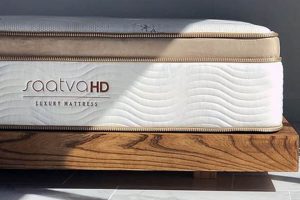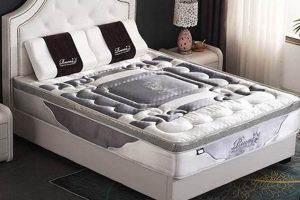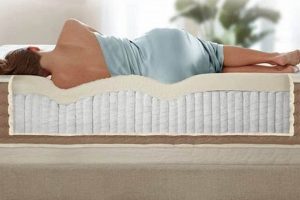The intersection of quality and affordability in sleep solutions represents a key consideration for consumers. This optimal point signifies a mattress that provides adequate support, comfort, and durability, all while remaining within a predetermined budgetary framework. A mattress offering advanced features, such as targeted lumbar support or cooling technology, may still be considered an excellent value if its cost aligns with prevailing market standards for similar products.
Securing a favorable equilibrium between investment and restorative sleep yields significant advantages. From a health perspective, a properly priced mattress encourages undisturbed rest, contributing to improved physical and cognitive function. Historically, advancements in manufacturing processes and materials have steadily broadened the range of viable mattress options, enabling consumers to access higher quality sleep surfaces at increasingly competitive price points.
The subsequent discussion will delve into the multifaceted nature of value assessment in the mattress market, encompassing factors such as material composition, construction techniques, warranty provisions, and consumer reviews, all of which play a critical role in determining the true long-term cost-effectiveness of a mattress investment.
Optimizing Mattress Value
The following recommendations provide strategies for identifying mattress offerings that represent optimal value within a specified budget. Prudent evaluation of product specifications and market conditions is essential.
Tip 1: Conduct Thorough Market Research: Compare prices across multiple retailers, both online and brick-and-mortar, to establish a baseline understanding of average costs for mattresses with comparable features. Consider utilizing price comparison websites.
Tip 2: Evaluate Material Composition: Understand the impact of different materials on both price and performance. Latex, memory foam, and innerspring constructions each offer distinct characteristics and associated costs. Determine which material best suits individual sleep preferences and needs while considering its price point.
Tip 3: Assess Construction Quality: Examine the mattress’s internal structure. Look for reinforced edges, durable stitching, and robust coil systems (if applicable). Higher quality construction often translates to extended lifespan and improved long-term value.
Tip 4: Scrutinize Warranty Terms: A comprehensive warranty provides assurance against manufacturing defects and premature wear. Pay close attention to the length of the warranty and the specific conditions covered. Longer warranties often indicate greater confidence in product durability.
Tip 5: Analyze Trial Periods and Return Policies: Many manufacturers and retailers offer trial periods that allow consumers to test the mattress at home. Carefully review the terms of the trial period, including any return shipping fees or restocking charges, prior to purchase.
Tip 6: Factor in Shipping and Delivery Costs: Consider potential delivery fees and associated charges, particularly for online purchases. Some retailers offer free shipping or white-glove delivery services, which can significantly impact the overall cost.
Tip 7: Read Customer Reviews: Examine feedback from previous purchasers to gain insights into mattress performance, durability, and customer service experiences. Pay particular attention to reviews that address issues such as sagging, overheating, or discomfort.
Diligent adherence to these guidelines facilitates informed decision-making, enabling consumers to secure a mattress that effectively balances cost considerations with desired comfort and longevity characteristics. Prioritizing careful research and product evaluation ultimately maximizes the return on investment in a sleep surface.
The subsequent section will explore strategies for negotiating mattress prices and identifying potential discounts or promotions.
1. Material Quality
The selection of materials constitutes a foundational determinant of mattress price and overall value. The inherent properties of these materials directly influence factors such as comfort, support, durability, and longevity, consequently impacting the long-term cost-effectiveness of the product.
- Foam Density and Composition
The density of foam, whether memory foam or polyurethane, significantly affects its ability to provide support and resist compression over time. Higher density foams generally command a higher price but offer superior durability and reduced risk of sagging. Furthermore, the specific chemical composition of the foam, including the presence of certifications like CertiPUR-US, indicates adherence to standards for low VOC emissions, potentially justifying a higher price point.
- Coil System Construction
For innerspring mattresses, the type and gauge of the coils are critical factors. Individually wrapped pocket coils tend to be more expensive than traditional interconnected coil systems due to their enhanced ability to contour to the body and minimize motion transfer. Coil gauge, measured in millimeters, indicates the thickness of the steel; thicker gauges offer greater support and durability but may also contribute to a higher price.
- Fabric Cover Material
The material used for the mattress cover influences breathability, temperature regulation, and overall comfort. Natural fibers such as cotton or bamboo may be more expensive than synthetic alternatives but offer superior moisture-wicking properties and reduced risk of skin irritation. The weave and construction of the fabric also contribute to its durability and resistance to wear and tear.
- Latex Source and Processing
Latex mattresses can be manufactured using either natural or synthetic latex, each with distinct price points. Natural latex, derived from rubber trees, is typically more expensive than synthetic latex, which is produced from petrochemicals. Within natural latex, different processing methods, such as Dunlop and Talalay, result in varying densities and feels, further influencing the price.
The interplay between these material attributes directly shapes the perception of a mattress’s value. While a lower-priced mattress may initially appear attractive, the use of substandard materials can lead to premature degradation and the need for more frequent replacements. Conversely, a mattress incorporating high-quality materials may represent a more prudent long-term investment, offering enhanced comfort, support, and durability despite its higher initial cost.
2. Construction Durability
The longevity of a mattress is intrinsically linked to its construction durability, representing a critical factor when evaluating the overall value propositio
n. A mattress exhibiting robust construction can withstand the rigors of nightly use for an extended period, mitigating the need for frequent replacements and thereby reducing long-term expenditure. Therefore, the assessment of construction durability is paramount in determining if a mattress aligns with the principle of offering the “best mattress price.”
- Edge Support Systems
Reinforced edge support systems, often employing high-density foam encasements or strategically placed coils, play a crucial role in preventing edge collapse and maintaining a consistent sleeping surface across the entire mattress. Mattresses lacking adequate edge support tend to exhibit premature sagging along the perimeter, reducing usable surface area and potentially leading to discomfort. A mattress with durable edge support, while potentially commanding a higher initial price, can offer superior longevity and overall value.
- Stitching Quality and Seam Reinforcement
The quality of stitching and seam reinforcement significantly impacts the structural integrity of a mattress. Robust stitching techniques, such as double-stitched seams, enhance resistance to wear and tear, preventing the separation of fabric panels and internal components. Inadequate stitching can lead to seam failure, resulting in shifting of materials and compromising the mattress’s comfort and support characteristics. Investment in a mattress with durable stitching represents a commitment to extended lifespan.
- Foundation Compatibility and Support
The type of foundation used in conjunction with a mattress can significantly influence its durability. Using an incompatible or inadequate foundation can accelerate wear and tear, potentially voiding warranty provisions. Solid, supportive foundations, designed to evenly distribute weight and provide adequate support, are essential for preserving the structural integrity of the mattress and maximizing its lifespan. The selection of an appropriate foundation, though an additional cost, contributes to the overall value proposition of the mattress.
- Internal Component Density and Weight Distribution
Density of interior materials is essential as it affects how well weight is distributed. High-density foams and heavy gauge coil systems ensure proper spinal alignment throughout the night, and prevent premature sagging by equally distributing pressure. A well-constructed mattress employs internal component density and weight distribution that will stand the test of time, therefore yielding better value and a cost-effective purchase.
In summary, construction durability serves as a cornerstone in the pursuit of the “best mattress price.” While the initial cost of a mattress with enhanced construction features may exceed that of less durable alternatives, the long-term benefits, including extended lifespan, consistent support, and minimized replacement costs, contribute to a superior value proposition. Therefore, prioritizing construction quality represents a strategic approach to securing a mattress that delivers optimal performance and enduring comfort.
3. Warranty Coverage
Warranty coverage serves as a critical component in determining the true value of a mattress, directly influencing the assessment of whether it represents an advantageous purchase. A comprehensive warranty provides recourse against manufacturing defects and premature degradation, mitigating potential financial losses and underscoring the importance of scrutinizing warranty terms when seeking the “best mattress price.”
- Defect Coverage and Duration
Mattress warranties typically cover manufacturing defects such as sagging, indentations exceeding a specified depth, faulty seams, and broken coils. The duration of the warranty, ranging from a few years to decades, is a key indicator of the manufacturer’s confidence in the product’s longevity. Longer warranties offer greater protection against unforeseen issues, potentially justifying a higher initial price point. Scrutinizing the specific defects covered, and the conditions under which the warranty is valid, is crucial to understanding its true value. For instance, a “lifetime” warranty may be prorated, with the consumer responsible for a portion of the repair or replacement cost after a certain period. Therefore, a shorter, more comprehensive warranty may prove more valuable than a seemingly longer, but limited, warranty.
- Pro-rated vs. Non-prorated Terms
A significant distinction exists between pro-rated and non-prorated warranty terms. A pro-rated warranty requires the consumer to bear an increasing percentage of the repair or replacement cost as the mattress ages. Conversely, a non-prorated warranty covers the full cost of repair or replacement for a specified period, providing greater financial security. Evaluating the terms carefully is essential, as a non-prorated warranty, even if shorter in duration, may offer superior protection against long-term defects, potentially contributing to a better overall value in the context of the “best mattress price.”
- Conditions and Exclusions
Mattress warranties often include specific conditions and exclusions that can impact their applicability. Common exclusions include damage resulting from improper use, stains, burns, or lack of adequate support (e.g., using an incompatible foundation). Adhering to the manufacturer’s guidelines regarding foundation type, mattress rotation, and proper care is essential to maintaining warranty validity. Understanding these conditions and exclusions is vital in assessing the actual value of the warranty, as non-compliance can render it void, potentially negating the perceived benefits of a lower-priced mattress with a seemingly attractive warranty.
- Claim Process and Customer Service
The ease and efficiency of the warranty claim process can significantly impact the overall consumer experience. A straightforward claim process, coupled with responsive customer service, enhances the value of the warranty, providing peace of mind and assurance that potential issues will be addressed promptly and professionally. Researching the manufacturer’s reputation for handling warranty claims is advisable, as a cumbersome or unresponsive claim process can negate the perceived benefits of even the most comprehensive warranty. Positive customer service experiences associated with warranty claims contribute to the perception of a mattress as offering the “best mattress price” in the long run.
In conclusion, a comprehensive understanding of warranty coverage, including defect coverage, pro-rated vs. non-prorated terms, conditions and exclusions, and claim process, is paramount in determining the true value of a mattress. A seemingly low-priced mattress with a limited or restrictive warranty may ultimately prove to be a less advantageous purchase than a slightly more expensive option with a robust and consumer-friendly warranty. Prioritizing thorough evaluation of warranty terms represents a strategic approach to securing a mattress that delivers optimal value and long-term peace of mind.
4. Trial Period Length
The duration of a mattress trial period directly influences the consumer’s ability to thoroughly assess a mattress’s suitability, thereby impacting the perceived and actual value proposition. A longer trial perio
d allows for more comprehensive evaluation of comfort, support, and overall sleep quality under varying conditions, directly affecting the determination of the “best mattress price.”
- Assessment of Long-Term Comfort and Support
Extended trial periods enable the user to evaluate the mattress’s ability to maintain consistent comfort and support over several weeks or months. This extended assessment is crucial for identifying potential issues such as sagging, softening, or development of pressure points that may not be apparent during a brief initial trial. A longer trial allows for adjustments in sleeping position and bedding arrangements, providing a more realistic assessment of the mattress’s suitability and its contribution to sustained restful sleep, justifying a higher price point if the mattress proves consistently comfortable.
- Accommodation to Individual Sleep Preferences
Individual sleep preferences, including firmness level, sleeping position, and sensitivity to motion transfer, necessitate an adequate trial period to ensure proper accommodation. A shorter trial may not allow sufficient time for the body to adjust to a new mattress, leading to premature and potentially inaccurate judgments regarding its suitability. Longer trials afford the user ample opportunity to experiment with different bedding configurations and adjust their sleeping habits to optimize comfort and support, resulting in a more informed decision regarding the mattress’s value and appropriateness for long-term use.
- Evaluation Under Varying Environmental Conditions
Seasonal changes in temperature and humidity can significantly impact the feel and performance of a mattress. A longer trial period spanning multiple seasons allows for assessment of the mattress’s ability to regulate temperature, wick away moisture, and maintain consistent comfort under varying environmental conditions. This extended evaluation is particularly important for individuals prone to overheating or those residing in climates with significant seasonal fluctuations. A mattress demonstrating consistent performance under diverse conditions justifies a higher price point due to its enhanced versatility and ability to provide comfortable sleep regardless of environmental factors.
- Risk Mitigation and Return Options
A generous trial period mitigates the risk of purchasing a mattress that proves unsuitable, providing the consumer with a recourse option in the event of dissatisfaction. The availability of a convenient and hassle-free return process enhances the perceived value of the mattress, as it reduces the potential for financial loss and ensures that the consumer can make an informed decision without undue pressure. A longer trial period coupled with a clear and straightforward return policy instills confidence and encourages investment in a potentially higher-priced mattress, knowing that recourse is available if the product fails to meet expectations.
In conclusion, the length of the trial period serves as a crucial determinant of perceived value in the mattress market. Extended trial periods allow for more comprehensive assessment of comfort, support, and environmental performance, mitigating risk and empowering consumers to make informed decisions. Mattresses offering longer trial periods and convenient return options often command a higher price point, reflecting the added value of reduced risk and enhanced consumer confidence, ultimately contributing to the determination of the “best mattress price” from a holistic perspective.
5. Sleep Technology
The integration of technological advancements into mattress design has significantly altered the landscape of sleep solutions, creating a spectrum of options that directly impact pricing structures and value assessment. These technologies aim to enhance comfort, support, and overall sleep quality, but their implementation often translates to increased manufacturing costs and, consequently, higher retail prices. Understanding the specific technologies and their purported benefits is crucial for determining if the added expense aligns with individual needs and preferences, ultimately influencing the determination of the “best mattress price.”
- Smart Fabric Technology
The incorporation of specialized fabrics engineered to regulate temperature and wick away moisture represents a prominent example of sleep technology. Phase-change materials (PCMs), for instance, absorb and release heat to maintain a consistent sleeping surface temperature. Similarly, fabrics infused with antimicrobial agents inhibit the growth of bacteria and allergens, promoting a healthier sleep environment. While these technologies may enhance comfort and hygiene, they also increase the cost of production. A consumer must weigh the potential benefits against the added expense to determine if the premium price is justified. The cost is warranted if an individual frequently wakes up due to discomfort from temperature. In such an instance, the incorporation of such technology would be beneficial to one’s sleep, and thus, price.
- Sensor Integration and Data Analysis
Some mattresses incorporate sensors designed to monitor sleep patterns, including movement, heart rate, and respiratory rate. This data is then analyzed to provide personalized insights into sleep quality and potential areas for improvement. While this technology offers the potential for enhanced self-awareness and optimized sleep habits, it also raises concerns regarding data privacy and security. Furthermore, the added complexity of sensor integration increases manufacturing costs, impacting the final price. A consumer must consider the value of this data-driven feedback and the associated privacy implications when evaluating the “best mattress price.”
- Adjustable Firmness Control Systems
Adjustable air chambers and integrated support zones represent another significant advancement in sleep technology. These systems allow users to customize the firmness and support levels of their mattress, catering to individual preferences and changing needs. While this technology offers enhanced personalization and adaptability, it also introduces potential points of failure and increases manufacturing complexity, thereby influencing the price. A consumer must assess the long-term reliability and potential maintenance costs associated with these systems when determining if the added expense is justified in the context of the “best mattress price.”
- Ergonomic Design and Zoned Support
Mattresses featuring zoned support systems are engineered to provide targeted support to different areas of the body, optimizing spinal alignment and reducing pressure points. These systems often incorporate varying densities of foam or strategically placed coils to cater to specific anatomical needs. While ergonomic design and zoned support enhance comfort and reduce the risk of pain and discomfort, they also require more complex manufacturing processes and specialized materials, impacting the price. A consumer must consider their individual postural needs and potential health benefits when evaluating the value of these features in the context of the “best mattress price.”
The decision to invest in a mattress incorporating advanced sleep technologies hinges on a careful assessment of individual needs, preferences, and budgetary constraints. While these technologies offer the potential for enhanced comfort, improved sleep quality, and personalized feedback, their implementation invariably increases the cost of production and, consequently, the re
tail price. A discerning consumer must weigh the purported benefits against the added expense, considering factors such as long-term reliability, data privacy, and potential maintenance costs, to determine if the investment aligns with their overall goals and the pursuit of the “best mattress price.”
6. Retailer Reputation
The correlation between a retailer’s reputation and the perceived “best mattress price” is significant. A retailer’s standing within the market, cultivated through years of operation, customer service, and product quality, invariably influences consumer perception of value. A positive reputation can justify a higher price point, as consumers are often willing to pay a premium for assurance of quality, reliable service, and a streamlined purchasing experience. Conversely, a retailer with a questionable history may struggle to command the same price, regardless of the inherent quality of the mattress itself. The retailer’s reputation acts as a filter through which consumers assess the overall worth of the mattress, often outweighing purely technical specifications.
Consider the example of two retailers offering an identical mattress model. Retailer A, a well-established business with a long history of positive customer reviews, transparent pricing policies, and a robust return policy, can likely sell the mattress at a higher price than Retailer B, a new entrant with limited customer feedback and a less flexible return policy. The perceived risk associated with purchasing from Retailer B is higher, leading consumers to demand a lower price to compensate for the lack of established trust. This effect extends beyond brick-and-mortar stores to online retailers, where reviews and ratings directly influence consumer confidence and willingness to pay. Retailers with a strong online presence and a history of fulfilling orders accurately and promptly benefit from enhanced consumer trust, allowing them to command more competitive prices. A poor experience is costly. It diminishes not only immediate earnings, but also discourages future sales.
In conclusion, retailer reputation functions as an intangible, yet crucial, component of the “best mattress price.” It represents the accumulated trust and assurance built over time, influencing consumer perception of value and willingness to invest. While technical specifications and material quality remain important considerations, the retailer’s reputation often serves as the deciding factor, justifying price discrepancies and ultimately shaping the consumer’s purchasing decision. Challenges arise when assessing the validity of online reviews and differentiating genuine feedback from biased or manufactured testimonials. However, a thorough examination of a retailer’s history, policies, and customer feedback provides valuable insights into its reputation, enabling consumers to make more informed decisions and secure a mattress that offers both quality and value.
7. Return Policy
A direct correlation exists between the stringency and comprehensiveness of a mattress return policy and its perceived value. A generous return policy reduces the risk associated with the purchase, influencing consumer willingness to pay a higher initial price. The assurance that a mattress can be returned if it proves unsuitable translates to enhanced consumer confidence and a greater acceptance of premium pricing. This principle operates on the understanding that the financial risk is mitigated by the option to return the product, effectively lowering the barrier to purchase. For example, a mattress priced at $1200 with a 100-night risk-free trial may be perceived as a better value than a comparable mattress priced at $1000 with a limited 30-day return window, or no return option at all. The “best mattress price,” therefore, encompasses not only the monetary cost but also the associated risk and the retailer’s commitment to customer satisfaction as demonstrated by the return policy.
The length and terms of the return policy directly impact consumer adoption rates and brand loyalty. Retailers offering extended trial periods, coupled with hassle-free return procedures, often experience increased sales volume and higher customer retention. This is because the return policy serves as a tangible expression of the retailer’s confidence in their product. However, overly lenient return policies can expose retailers to potential abuse, such as customers purchasing mattresses for temporary use and then returning them. To mitigate this risk, many retailers implement specific conditions, such as requiring the mattress to be in reasonable condition and free from stains or damage. The effectiveness of the return policy, therefore, hinges on a delicate balance between consumer protection and retailer safeguards. Practical application of this understanding enables consumers to weigh the risks and rewards associated with different return policies, ultimately influencing their purchasing decisions. For instance, someone who is unsure about their mattress preferences may lean towards a product that provides a generous return policy to alleviate that decision pressure.
In summary, the return policy is an integral component of the “best mattress price” equation. It functions as a risk mitigation tool, enhancing consumer confidence and potentially justifying a higher initial cost. The optimal return policy balances consumer protection with retailer viability, ensuring a positive purchasing experience while minimizing potential abuse. The challenge lies in discerning the true value of a return policy, considering factors such as trial length, return conditions, and the retailer’s reputation for honoring returns promptly and fairly. Therefore, a comprehensive understanding of return policy terms is essential for making an informed mattress purchasing decision and securing the best overall value.
Frequently Asked Questions Regarding Mattress Pricing
This section addresses common inquiries and misconceptions surrounding mattress pricing, offering objective and informative responses to guide consumer decision-making.
Question 1: What constitutes a “good” price for a mattress?
A “good” price for a mattress is subjective and dependent on individual needs and preferences. Factors such as mattress type (innerspring, memory foam, latex), size, materials, and construction influence the overall cost. A prudent approach involves researching average prices for comparable mattresses within a specific category and assessing whether the features and benefits align with individual sleep requirements and budgetary constraints. Prices vary significantly with store, brand, and time of the year.
Question 2: Are online mattress retailers generally cheaper than brick-and-mortar stores?
Online mattress retailers often offer lower prices compared to traditional brick-and-mortar stores due to reduced overhead costs (e.g., rent, utilities, sales staff). However, this is not always the case. Brick-and-mortar stores may offer clearance sales, closeouts, or promotional discounts that can result in competitive pricing. Furthermore, brick-and-mortar stores allow for physical inspection and testing of mattresses, which can be beneficial for some consumers. It’s crucial to compare prices across multiple channels before making a decision.
Question 3: Do mattress prices fluctuate throughout the year?
Yes, mattress prices are subject to seasonal fluctuations, wit
h promotional periods typically occurring during holidays such as Memorial Day, Labor Day, Black Friday, and Cyber Monday. Manufacturers and retailers often offer significant discounts during these periods to stimulate sales. However, it’s essential to compare prices carefully, as some retailers may inflate the original price before applying a discount. Price trends may vary from year to year, which is why tracking price history may be useful when making a purchasing decision.
Question 4: Is it possible to negotiate the price of a mattress?
Negotiating the price of a mattress is often possible, particularly at brick-and-mortar stores. Sales associates may have the discretion to offer discounts or match competitor pricing to secure a sale. However, negotiation may be less common with online retailers, where prices are typically fixed. Persistence and a willingness to walk away can sometimes result in a more favorable price. This practice is common, though individual results may vary.
Question 5: What are the hidden costs associated with mattress purchases?
Hidden costs associated with mattress purchases can include delivery fees, disposal fees for old mattresses, the cost of a compatible foundation or bed frame, and the expense of mattress protectors or encasements. These additional costs can significantly increase the overall price of the purchase. It’s prudent to inquire about all potential fees before committing to a purchase to accurately assess the total cost. Taxes are also an important consideration.
Question 6: Does a higher mattress price always equate to better quality?
A higher mattress price does not necessarily guarantee superior quality. While more expensive mattresses often incorporate higher-quality materials and advanced construction techniques, price alone is not a reliable indicator of overall value. It’s essential to evaluate the specific features, materials, warranty, and customer reviews to determine if the mattress justifies its price. Marketing and branding influence consumer choices; price is only one component of this.
In summary, navigating the complexities of mattress pricing requires careful research, price comparison, and a thorough understanding of individual needs and preferences. A prudent approach involves considering all factors, including mattress type, materials, features, warranty, retailer reputation, and hidden costs, to make an informed decision that balances cost and value.
The following section will provide guidance on selecting the right mattress type based on individual sleep preferences and needs.
Best Mattress Price
The preceding discussion has dissected the multifaceted nature of the “best mattress price,” underscoring its significance as a strategic imperative for consumers seeking optimal value in the sleep solutions market. Key considerations, including material quality, construction durability, warranty coverage, trial period length, sleep technology, and retailer reputation, have been explored in detail, emphasizing the interconnectedness of these factors in determining overall cost-effectiveness. The analysis reveals that securing a mattress that truly embodies the “best” price requires a discerning approach, prioritizing informed decision-making over superficial price comparisons. Understanding the interplay of these factors empowers the consumer to find a mattress that offers value.
The pursuit of the “best mattress price” represents an investment in personal well-being and long-term health. By prioritizing diligent research, product evaluation, and a comprehensive understanding of the factors influencing mattress value, consumers can secure a sleep surface that delivers both comfort and cost-effectiveness. The future holds the continued expansion of sleep technologies and materials, requiring ever more dedicated due diligence. The path toward a better night’s sleep is attainable through informed choices and a commitment to prioritizing value over fleeting savings.






![Top-Rated: Best Twin Size Air Mattress [Guide] Organic & Natural Mattress Buyer’s Guide: Non-Toxic Sleep Solutions Top-Rated: Best Twin Size Air Mattress [Guide] | Organic & Natural Mattress Buyer’s Guide: Non-Toxic Sleep Solutions](https://mattressworldpa.com/wp-content/uploads/2025/07/th-7636-300x200.jpg)
